Updated Result
01/12/2010 (Mw 7.0), Haiti
Anthony Sladen, Caltech
Location of Epicenter |
Amount of Slip on Fault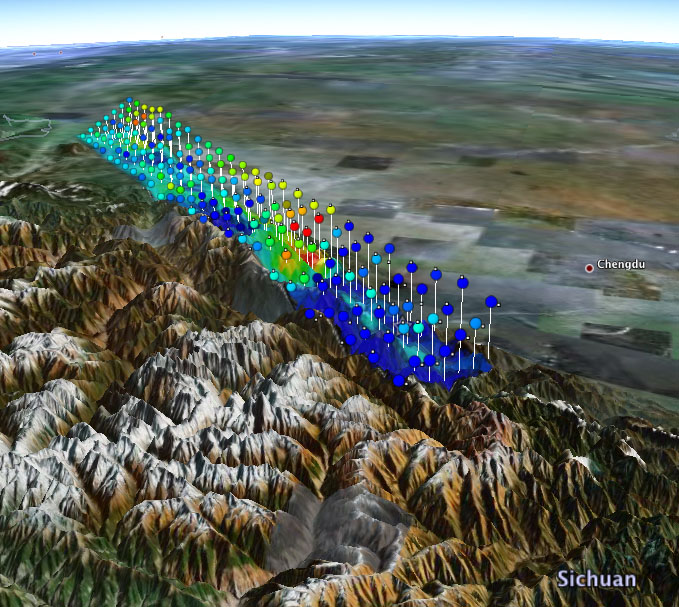
View in Google Earth (requires Google Earth) Colors show the amount of slip on diferent sections of the fault zone. Two views are shown (either view can be de-selected on the Google Earth sidebar):
|
Overview
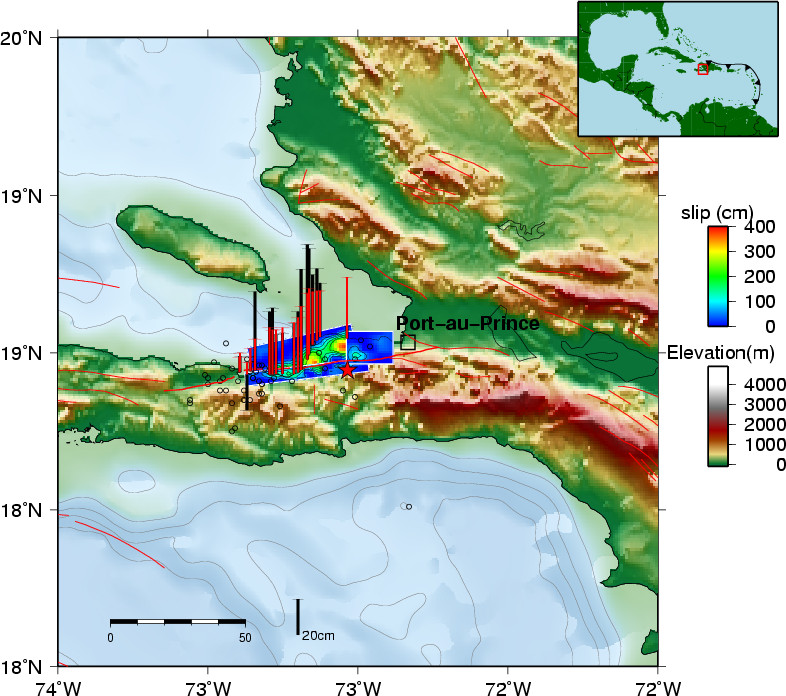
|
Haiti is located at the boundary between the Caribbean plate and the North America plate.
The rectangles in the figure show the location and length of the earthquake ruputure zone along this boundary. The red star indicates the epicenter. The rupture extended about 35 km (22 miles). The colors show the slip amplitude (i.e., the amount by which the land on one side of the fault moved with respect to the land on the other side). The motion was mainly strike-slip (i.e., land on one side of the fault moving horizontally with respect to land on the other side). The rupture originated at the epicenter (red star) about 10 km (6 miles) below the surface. In some places, the vertical slippage along the fault line was as large as 4 meters (12 feet), shown by red-shaded areas. This slip map was generated from a numerical model that uses seismological records from all over the world and the static data include InSAR and coral measurements. Please see Hayes et. al. for more details. |
DATA Process and Inversion
This is an update of our preliminary analysis based on the results in Hayes et. al. (2010) . We used the GSN broadband data downloaded from the IRIS DMC. We analyzed 29 teleseismic P waveforms selected based upon data quality and azimuthal distribution. Waveforms are first converted to displacement by removing the instrument response. 4 InSAR images and 19 uplift measurements determine by coral methods were used together with seismic data to constrain the slip history based on a finite fault inverse algorithm (Ji et al, 2002). The epicenter location is slightly shifted from the USGS estimate (Lon.= -72.445 ° Lat.=18.505 °) but not the depth (10 km). Three fault planes with strikes of 83°/257°/90°, dips of 70°/55°/45° are used during the inversion. The 1D velocity model is extracted from the CRUST2.0 global tomography model (Bassin et al., 2000).Result
The blind thrust fault (strike 257° and dip 55 °) is responsible for about 80% of the moment released during the event, and the inversion predicts maximum slip of approximately 3.5 m.Cross-section of slip distribution
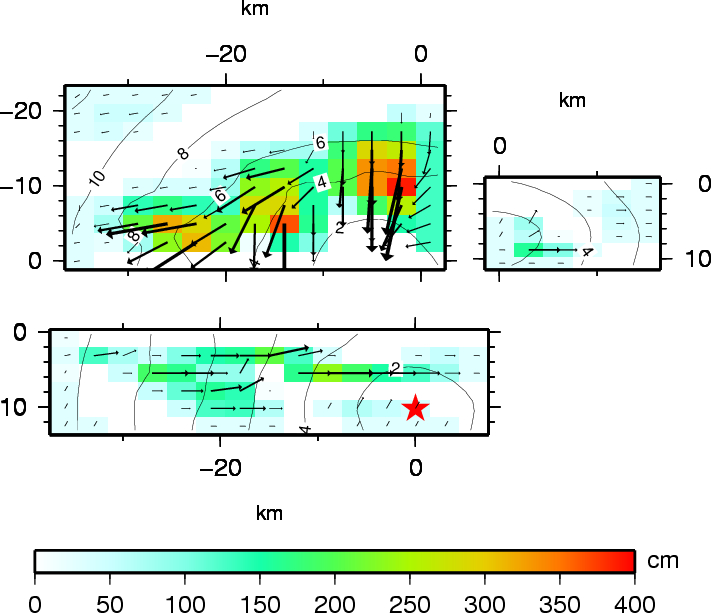
Figure 1: The colors show the slip amplitude and white arrows indicate the direction of motion of the hanging wall relative to the footwall. Contours correspond to the propagation of the rupture front, and the red star indicates the hypocenter location. The big black arrow gives the orientation of the fault plane. Note the depth of the upper left fault plane (strike=257°,dip=55°) is plotted in opposite way compare with other two.
Comparison of data and synthetic seismograms
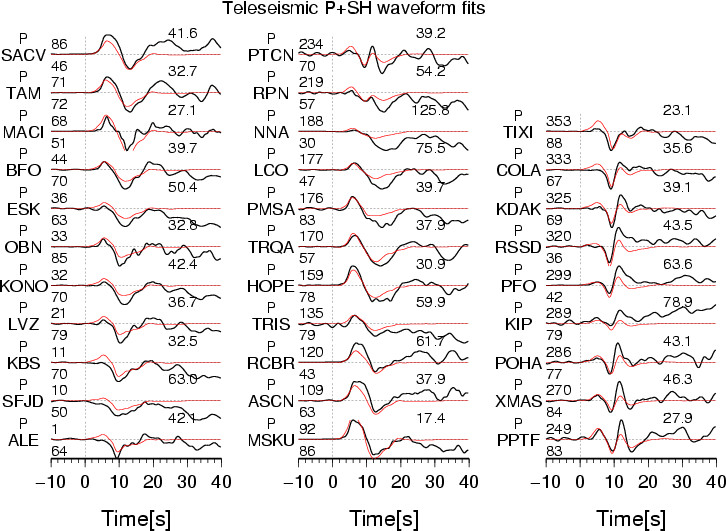
Figure 2: The Data are shown in black and the synthetic seismograms are plotted in red. Both data and synthetic seismograms are aligned on the P or SH arrivals. The number at the end of each trace is the peak amplitude of the observation in micro-meter. The number above the beginning of each trace is the source azimuth and below it is the epicentral distance.
Map view of the slip distribution

Figure 3: Surface projection of the fault plane slip distribution. The red star represents the epicenter of this event. The open circles are the aftershocks located by USGS in the days following the event. Vertical static offset observations (black bars), compared to predictions (red bars) from our proposed model, overlain on surface projection of the coseismic slip distribution.
InSAR data fits
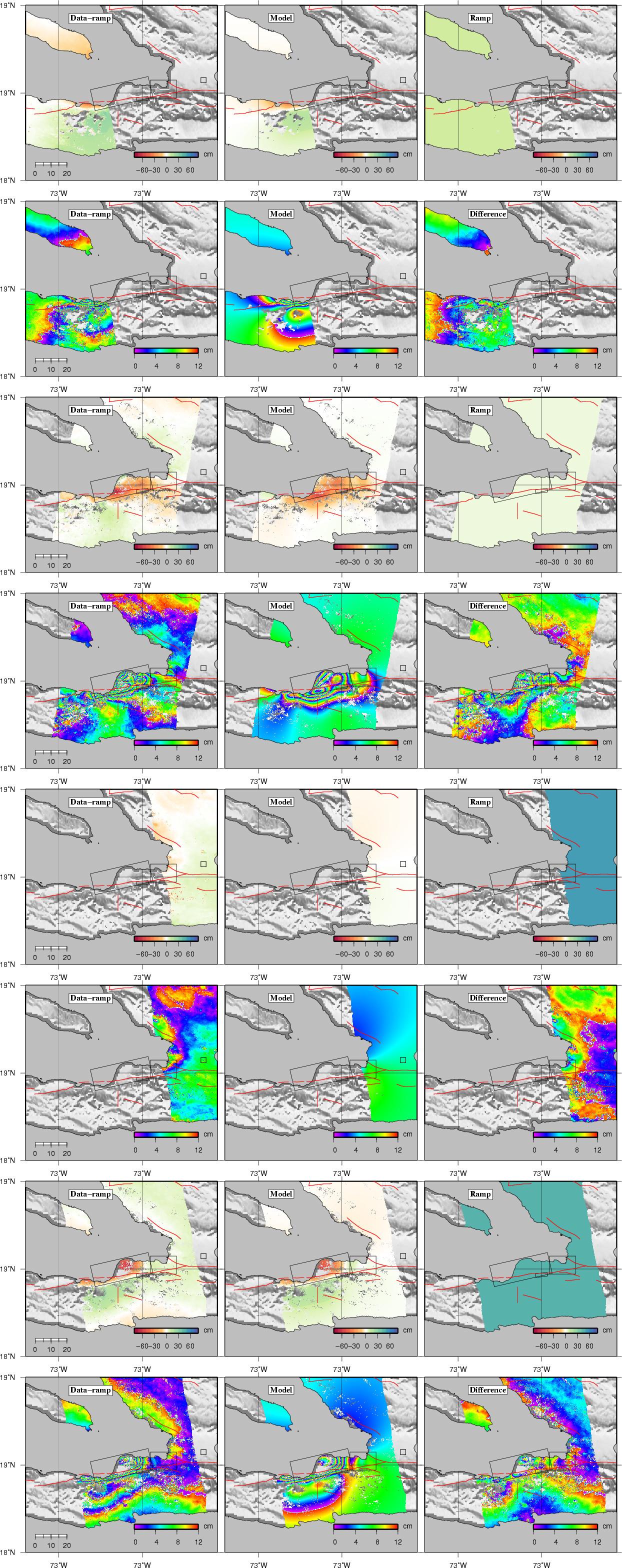
Figure 3: InSAR data fits for proposed kinematic rupture model. Model fits are shown for each of the 4 unwrapped ascending and descending (top), and wrapped descending (bottom) ALOS PALSAR interferograms. The first and second columns show the data and model. The third column describes the residual between the model and data. ˇ°Rampˇ± describes the correction applied to the InSAR images to account for uncertainties in the signal, such as orbital errors.
Comments:
Download
(Slip Distribution)
| SUBFAULT FORMAT | SOURCE TIME FUNCTION |
References
Hayes, G. P., R. W. Briggs, A. Sladen, E. J. Fielding, C. Prentice, K. Hudnut, P. Mann, F. W. Taylor, A. J. Crone, R. Gold, T. Ito & M. Simons, Complex rupture during the 12 January 2010 Haiti earthquake , Nature Geoscience , 3, 800-805, 2010.
Ji, C., D.J. Wald, and D.V. Helmberger, Source description of the 1999 Hector
Mine, California earthquake; Part I: Wavelet domain inversion theory and resolution
analysis, Bull. Seism. Soc. Am., Vol 92, No. 4. pp. 1192-1207, 2002.
Bassin, C., Laske, G. and Masters, G., The Current Limits of Resolution for
Surface Wave Tomography in North America, EOS Trans AGU, 81, F897, 2000.
GCMT project: http://www.globalcmt.org/
USGS National Earthquake Information Center: http://neic.usgs.gov
Global Seismographic Network (GSN) is a cooperative scientific facility operated jointly by the Incorporated Research Institutions for Seismology (IRIS), the United States Geological Survey (USGS), and the National Science Foundation (NSF).